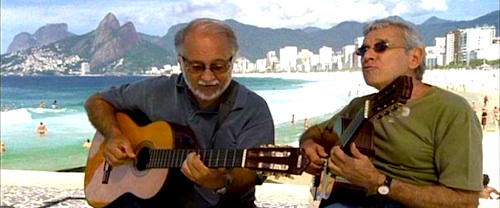By Joe Bendel. Bossa Nova originally started as a spontaneous synthesis of West Coast Jazz, Samba, Romantic Era classical music, and influential Brazilian songwriters, like Ary Barroso. However, American jazz artists adopted Bossa Nova rhythms, re-importing the music back into jazz. For a while in the 1960s, everyone released a Bossa Nova album. Some were legit, some were legit-ish. Two of the first generation Bossa Nova artists take viewers back to where it all began in Paulo Thiago’s This is Bossa Nova, which opens this Friday in New York.
When it comes to Bossa Nova, Carlos Lyra and Roberto Menescal are the real deal. Essentially, they found each other and a group of like-minded musicians when they were all exploring “modern” sounds and less maudlin, more contemporary lyrics. A slightly older staff arranger named Antonio Carlo “Tom” Jobim took them under his wing, helping polish some of their compositions and writing scores of his own standards with them in mind.
Lyra and Menescal frequently visit the campuses, flats, and concert halls where the music was incubated, often carrying their guitars (and a tune along with them) troubadour-style. It is a much more active, entertaining way to take a trip down memory lane. Of course, all the greats, like Jobim, João Gilberto, and Oscar Castro-Neves were just as great as we always thought, but Lyra and Menescal also make a case for less prominent artists, including influential predecessors, such as Johnny Alf (the legendary Hotel Plaza jazz pianist) and Sinatra-esque bandleader Dick Farney.
There are a wealth of archival performances collected in TIBN, including Jobim performing and discussing “One Note Samba” with Gerry Mulligan (on clarinet), as well as a bounty of original renditions from Menescal, Lyra, his daughter Kay Lyra, Leny Andrade, Wanda Sá, João Donato, and the late great Alf. It is worth noting his piano trio is unusual well mic’d and mixed—you can actually hear the bass. Kay and Carlos Lyra also sound quite lovely on “Voce E Eu,” but this probably wasn’t their first time working together.
There are some cool associations that come to light throughout TIBN, like the influence Barney Kessel’s sessions with Julie London had on Carlos Lyra. Thiago also devotes sections to vocalist Nara Leão, Vinicius de Moraes (whose play was adapted as Black Orpheus), and journalist-lyricist Ronaldo Bôscoli, whom he dubs the “Muse,” “Poet,” and “Theorist” of Bossa Nova.

This is a terrific film that gives viewers many complete performances and a considerable insight into the music we hear. Lyra and Menescal are perfect hosts. They exude laidback charm and have all the credibility in the world. Cinematographer Guy Gonçalves makes it all look pleasantly bright and inviting. It is really the perfect film for a warm summer’s night on the beach or a winter in New York City. Absolutely charming and gently infectious, This is Bossa Nova is indeed highly recommended when it opens this Friday (1/1) in New York at the Cinema Village.
LFM GRADE: A
Posted on December 31st, 2015 at 7:37pm.